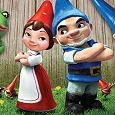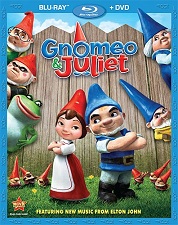 Written by William Shakespeare in the late 16th century, the play Romeo and Juliet has never ceased to be a source of inspiration for authors and all kinds of creators. From opera (Gounod, Berlioz, Tchaïkovski…), ballet (Prokofiev), musical (notably West Side Story), or cinema (Cukor, Zefirelli, Lurhmann…), the tragic love story had never been adapted to theatrical animation…until now! With Gnomeo and Juliet, writer/director Kelly Asbury imagined the most unexpected setting for the story – the English garden and its garden’s gnome culture, using Elton John’s songs as a funny and clever counterpoint to that universe.
Written by William Shakespeare in the late 16th century, the play Romeo and Juliet has never ceased to be a source of inspiration for authors and all kinds of creators. From opera (Gounod, Berlioz, Tchaïkovski…), ballet (Prokofiev), musical (notably West Side Story), or cinema (Cukor, Zefirelli, Lurhmann…), the tragic love story had never been adapted to theatrical animation…until now! With Gnomeo and Juliet, writer/director Kelly Asbury imagined the most unexpected setting for the story – the English garden and its garden’s gnome culture, using Elton John’s songs as a funny and clever counterpoint to that universe.
During his 27-year career as an animation artist, Asbury has served many creative capacities on some of Hollywood’s most popular animated films, including Shrek (2001), Toy Story (1995), Tim Burton’s The Nightmare Before Christmas (1993), Beauty and the Beast (1992) and The Little Mermaid (1989). In addition to films, he is a noted author and illustrator of several published children’s books, as well as having written and compiled the offbeat, non-fiction book Dummy Days: America’s Favorite Ventriloquists from Radio and Early TV (Angel City Press, 2003).
Ahead of next Tuesday’s release of Gnomeo and Juliet on DVD and Blu-ray, Animated Views was kindly invited by Walt Disney Studios Home Entertainment to take part in a roundtable interview with the director.

Roundtable Interviewer: You have been in the business for quite a long time now and already worked on projects like Shrek, Toy Story, Beauty and the Beast and The Little Mermaid. How has the industry changed over the past 20 years?
Kelly Asbury: I began in the animation business in 1983 and have been able to be part of an unbelievably exciting – make that THRILLING – growth period that just keeps getting better.
RI: Which animated film made you think, “I want to make one of those one day?”
KA: Around 1967, when I was 7 years old, I saw Walt Disney’s Snow White and remember saying to my mom: “I have to learn how to make my drawings move like that!” From there, I was hooked.
RI: How was the idea behind Gnomeo & Juliet born?
KA: The movie was first pitched to Elton John’s London based Rocket Pictures, several years before I became involved, by writers Rob Sprackling and John Smith (ironically, neither of whom I’ve actually ever met). So, Elton is the one who got in touch with me. His company Rocket Pictures teamed with Disney to make this film. I was invited to join the party! Lucky me!
RI: Was it always going to be a mix of old tunes (along with a few new ones), or was there ever the chance of a whole new score, a la Lion King?
KA: I wanted to use Elton John and Bernie Taupin’s classic songs – and a few new ones – in much the same way the music of Simon and Garfunkel was used in The Graduate: to cue the audience into the emotion of a given scene. It took a lot of experiementation and evolution to arrive at the choices that were finally made.
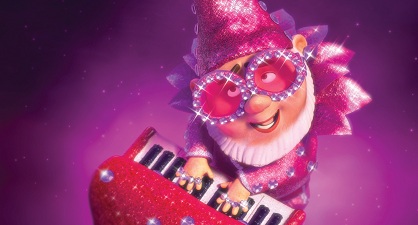
RI: How did you work with James Newton Howard on the score? How did you connect the songs and the score?
KA: James Newton Howard and his associate Chris Bacon delivered exactly the type of inventive score I dreamt of for this movie, utilizing classic Elton John melodies, while also providing exciting, new, original music as well. I hope to work with either of them again and again. They could not have been more open, generous and collaborative.
RI: What was the hardest sequence to work on in this film and why?
KA: The most difficult sequence in Gnomeo and Juliet was “Where to begin?” Opening any story is tricky, but this one really got down to the wire. There was a lot of back story that had to be established in as simple a way as possible and it took a lot of trial and error.
RI: How long did it take to write the screenplay?
KA: Animated features take up to three years to fine tune and discover all the various aspects of the story. The actual writing of that screenplay is an ongoing, ever changing process and involves more than the written word. It’s a smuch about the storyboards as it is the script. While a screenplay certainly is the starting point, the visual story reel – a temporary version of the movie told in real time using still drawings, temporary voices, sound and music – becomes the blueprint. That story reel is in a constate state of revision and is the tool used to test whether a movie is working. Basically, animated movies are fully planned and edited BEFORE the are actually put into production. In effect, we make the movie twice: once as a story reel and once as the finished, animated, rendered movie.
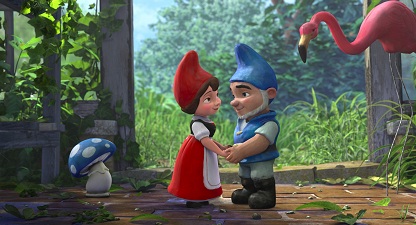
RI: What did you feel were some of the pitfalls of redoing the often-adapted Romeo and Juliet with garden gnomes?
KA: Taking on any classic is a precarious endeavor, but I tried to keep it light-hearted and clearly satiricle. More than anything Gnomeo and Juliet is meant to be fun, a romp.
RI: Did you travel outside of America to look at others countries garden’s gnomes? Germany is supposed to be the homeland of gnomes…
KA: I certainly explored the whole world gnome culture, which does vary from country to country. Germany’s Black Forest seems to be where all the gnomes originally came from, at least the “Forest Gnome” variety, who supposedly live among us, but remain out of our sight. Gnomeo and Juliet centers on the “Good Luck Garden Gnomes” who watch over our flowers and shrubs. While I didn’t travel to Germany for this information, I certainly studied it all…More so than I ever imagined I would.
RI: For Gnomeo and Juliet you moved for one and a half years to London. What experiences did you have living abroad?
KA: I think living in an exciting, “melting pot” city such as London has been one of the most – if not the most – enriching life experiences I could imagine. I truly believe I’m a better, more open, tolerant person for it. When it gets right down to it, people really are all the same.
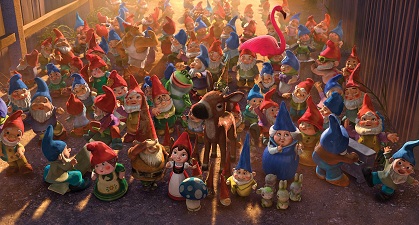
RI: What’s the sequence you’re most proud of in this film, and why?
KA: I have to admit that I am partial to the sequence when our star-crossed gnomes, Gnomeo and Juliet, first meet on the roof of that old greenhouse. I love the song “Hello, Hello” and I love the general look and animation of that entire piece.
RI: How much input did you have on what actors voiced which characters?
KA: I was able to have complete input regarding the actors who were cast in the movie. The casting director, Gale Stevens, would send me several choices of voice smaples for each character – and I would ask her not to tell me who the actor was. My producers and I would listen to these voices while looking at pictures of the given character and if the voice seemed to fit, we’d take it from there. It really was a prcoess of elimination to arrive at a given casting choice. Fortunately, the studio agreed with all my ultimate choices and I got the cast I wanted.
RI: Ewan McGregor and Kate Winslet were reportedly cast as Gnomeo and Juliet. At what point did James McAvoy and Emily Blunt come on board?
KA: When I was asked to be diretcor on the film, it had already been developed in various scattered versions for several years. No final casting choices had yet been made. I wanted to start with a clean slate.
RI: As director, how much input did you have in creating the looks of each of the characters?
KA: One of the joys of my job is to be part of every creative decision on the movie. I worked very closely with character designer Gary Dunn, who did an amazing job of keeping our gnomes appealing – while still looking like gnomes…not always an easy task.
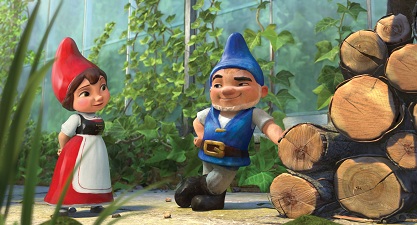
RI: I see you really like to get involved with the creation of your movies, for this movie Gnomeo and Juliet about how many different characters did you portray and did you have a favorite character that you portrayed?
KA: In Gnomeo and Juliet I played all seven of the little “Goon Gnomes” who follow Tybalt. They all have the same voice, so it was easy. I also played the opening narrator gnome…but he’s one of the Goons too, so he had the same voice. I love doing voices and hope to continue doing them, not only on my movies, but anyone who asks me. It’s very fun.
RI: Regarding animation, there are many styles to choose from. Some more realistic, some with a cartoon style, stop-motion technique and also some using the classic hand drawn cartoons style. What made you go with this specific style of CG animation?
KA: I wanted Gnomeo and Juliet to look as “real” as possible and CG provided that best.
RI: It seems like there is a lot more adult humor incorporated in animated films like Gnomeo & Juliet. When writing these types of jokes that are supposed to go over the heads of kids and be a nod and wink to their parents, how far is too far?
KA: Those answers come as the story reel gets tested and revised. It becomes clear when a joke goes to far or simply doesn’t work like I’d hoped. The story reel is the best tool I have as a filmmaker. It contains all my answers. It’s my job to pay attention and learn from it.
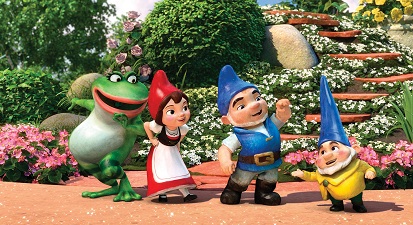
RI: Gnomeo and Juliet was often accused of “being too referential for its own good.” How would you respond to that assessment?
KA: It’s difficult to say. Many people have told me how much they love the referential humor. It really depends on one’s own sensibility I suppose. I, for one, am a huge Mel Brooks fan, and I love satirical movies like the Zucker Brothers’ Airplane. I grew up reading MAD magazine…I guess all that rubbed off a little.
RI: Kelly, any final thoughts on Gnomeo & Juliet as we close today’s virtual roundtable?
KA: My colleagues and I wanted to make Gnomeo and Juliet a fun, easy to watch, entertaining movie. “Fun” was the key word from day one. I hope we achieved that. I like to laugh and I love to hear other people laugh. I don’t think the world can have too much laughter and fun, in or out of a movie theater.
RI: In the end, have you come to embrace the garden gnome culture after this?
KA: I actually now have more garden gnomes than I ever thought possible. People give them to me as gifts!
With thanks to Kelly Asbury, Brigid d’Arcy and the WDSHE team!


